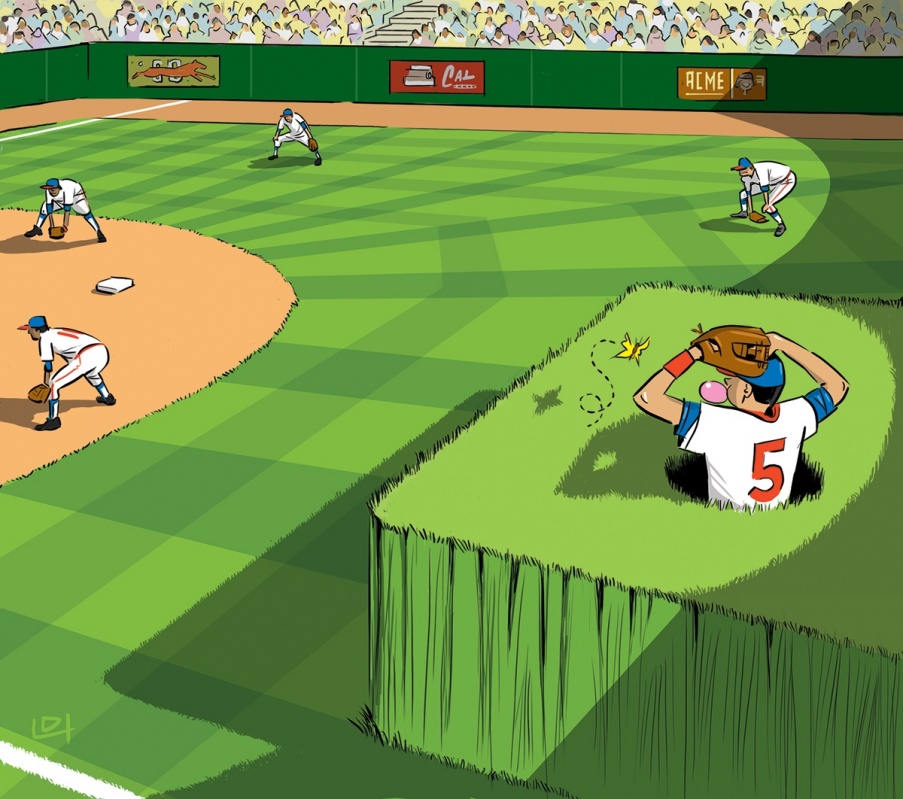My years as a softball bum came to an inglorious end several years ago when the callous coach of an Austin slow-pitch team sent me to right field.
“So,” I thought as I trotted out to the game’s loneliest position. “It’s come to this.”
The relegation to right field also completed a circle that began with my first season of Little League, when I was 8. Even then I knew right field was the place they send you when they don’t have confidence in your ability to track and catch a ball. The typical Little League right fielder’s idea of catching a ball is to wait until it stops rolling then pick it up.
Without getting too technical for the baseball-challenged: Little Leaguers generally don’t hit the ball to right field because most are right-handed and tend to send the ball toward the left side of the field. They might pop one into right field by swinging a tad late on a pitch, but the typical Little League pitcher doesn’t throw hard enough to make that likely.
Right fielders on slow-pitch softball teams see even less action than Little Leaguers because, well, it’s slow pitch. You can practically go get a drink of water when the pitcher lets the ball go and still be back at the plate in time to whack one over the left-field fence. When a left-handed batter comes up, the more calculating teams switch their right and left fielders, demonstrating to one and all that the right fielder might be a good person but a sorry ballplayer.
As a kid, I worked my way out of right field and played every other position except first base (too short) and catcher (too skinny) as part of organized ball. I went from batting last to batting leadoff. I played a little high school ball and joined summer-league teams until my late teens then moved to Austin and became a softball bum, usually playing shortstop or left field. My chosen lifestyle endeared me to my buddies a lot more than to my creditors, who cared not at all that I was batting .600 for a city league B team and hadn’t made an error in four straight games.
One summer, as the coach of a Little League team, I had to explain to a despondent right fielder-to-be that some of the greatest players in the game—legends like Roberto Clemente, Roger Maris and Hank Aaron—patrolled right field on their way to the Hall of Fame. This kid had never heard of any of those guys. Off to right field he went. Later I realized I should have mentioned Babe Ruth, who also played right field at times. Surely the kid had heard of him.
I thought of that reluctant player while I was in right field during my last “official” softball game. Not much happened. No surprise, since I was, after all, in right field. I do remember one fly ball near the foul line that I caught without too much trouble. I tossed the ball to the center fielder, who threw it back to the infield for me because I’ve got this bad rotator cuff that I tore playing all those positions other than right field. Hurts like hell when I try to throw hard.
A few years after hanging up my glove for good, I happened to be in the stands watching a Little League game in Georgetown when I spied a secluded and forgotten right fielder sitting cross-legged on the grass, staring intently at what I guessed was a caterpillar crawling across the fingers of what would have been his glove hand—if his glove hadn’t been several feet away.
Then the unthinkable happened: Someone smashed a hard line drive to right field! There wasn’t even time to holler a warning as the ball whizzed directly toward the boy and his insect with unsettling velocity. The caterpillar-absorbed right fielder avoided a ground-rule concussion when the ball hit a few feet in front of him, bounced high over his head and rolled all the way to the fence.
By then, base runners were circling the bases while everybody in the park—even the players on the other team—were yelling at the right fielder to go get the ball. The ball! Go get the ball! He looked up, puzzled. A ball? You need a ball? OK. He stood up, reached into his back pocket and pulled out a ball he just happened to have with him, lobbed it in the general direction of the hollering and then started looking around in the grass for his caterpillar, which must have fallen by the wayside during all the excitement.
Although not all Little League right fielders graduate to positions of power like pitcher or shortstop, I’ll bet at least some of them grow up to be entomologists or scholars because right field can be a great study hall for any number of activities—even baseball which, like life, always finds you, no matter what position you play.
——————–
Clay Coppedge, a member of Bartlett EC, lives near Walburg.


